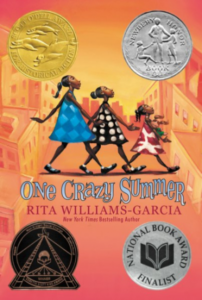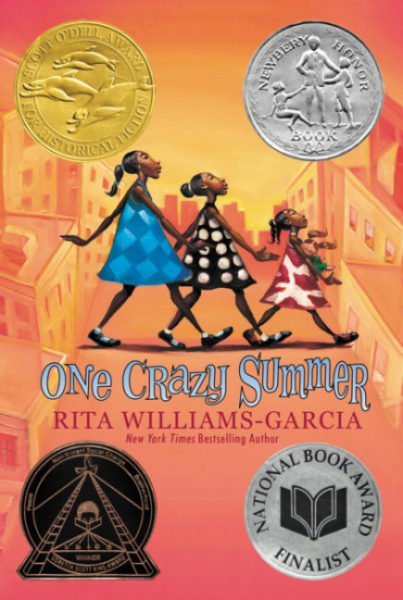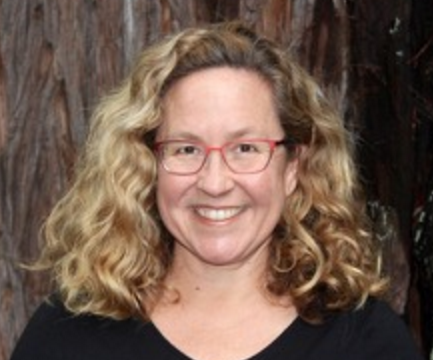Craft Review by Beth Mitchell

One Crazy Summer by Rita Garcia-Williams (Amistad, 2010)
The historical setting of One Crazy Summer is what first caught my eye. The story takes place in Oakland, California in the tumultuous summer of 1968. What captured my imagination, though, are its vivid characters.
One Crazy Summer is the story of the three Gaither sisters’ journey from Brooklyn to Oakland to spend a month with the mother who left them seven years earlier. The girls’ California adventure does not start off as they’d hoped. Their mother Cecile, or Nzila as she now calls herself, is more interested in poetry and politics than mothering. Instead of welcoming them with a hug and a home-cooked meal, she sends Delphine, Vonetta, and Fern down the street for Chinese take-out. Instead of taking them to Disneyland, she sends them to the People’s Center for a summer camp run by the Black Panthers.
The story is told from the first person POV of eleven-year-old Delphine, the responsible eldest sister. As a reader, I feel like I know Delphine. As a writer, I want to understand how Rita Williams-Garcia makes that happen.
I recently watched a thought-provoking webinar with Lisa Cron and Jennie Nash in which they argue that backstory is the “most potent layer” of a novel, and writers make a mistake when they try to keep it off the page. They explain that novels begin in medias res, or in the middle of a story that has its origins in the protagonist’s past. When the protagonist’s backstory is revealed in the novel, it is never merely an interesting anecdote. Rather, it’s the “yardstick the protagonist uses to gauge the meaning of what’s going on in the present.” In order to create this potent layer, writers need to know the relevant parts of their protagonist’s history in detail.
Williams-Garcia clearly knows Delphine—not just what happens to her during the four weeks of the novel—but what happened to her in the past to cause her to see the world the way she does. And she skillfully weaves this backstory into every chapter of One Crazy Summer.
Novels Begin In Medias Res
The opening scene of One Crazy Summer takes place on the airplane. The girls have left their Pa and Big Ma behind in New York to travel alone to California. Delphine is in charge of her sisters, calming them during the turbulent flight and preparing them to face the mother who abandoned them.
The roots of Delphine’s story reach from this beginning point all the way back to her earliest memories of her mother. Throughout the novel, Williams-Garcia reveals the events that led up to this moment:
- A few weeks earlier: Delphine and her sisters overheard their Pa say: “No, Ma. They need to know her, and she needs to know them. They’re flying to Oakland. That’s final.” (p. 43)
- Many years earlier: The girls faced questions from other children in Brooklyn: “Where’s your mother? Why don’t she live with you? Is it true she died?” (p. 21)
- Seven years earlier: Cecile gave Vonetta a cookie, gave the baby milk and a doll, told Delphine to be good and wait for Papa, and left. (p. 210)
- Before Fern was born: Delphine sat quietly in the kitchen with Cecile while she wrote poetry, listened to Sarah Vaughn, and ignored Vonetta’s crying. (p. 147)
In a sense, the events of the novel are the second part of the story of Delphine’s complicated relationship with her mother.
Action: Before you write page one, make sure you know how your protagonist got to that point in her story.
Backstory Is Never Just an Anecdote
Williams-Garcia includes backstory on nearly every page, but these details do not slow the forward momentum of the plot because Delphine uses her childhood memories to figure out her mother’s new world.
Sometimes her backstory comes out in a flash of memory. For instance, the clean, painted walls of her mother’s house surprise Delphine because she remembers her mother writing poetry on the walls of their apartment in Brooklyn. (p. 25)
Sometimes Delphine hears Big Ma’s words in her head. While she tries to wash the black ink off her little sister’s doll, she remembers how Big Ma taught her to “scrub like … a gal from a one-cow town near Prattville, Alabama” so as not to end up a dreamy poet like her mother. (p. 95)
Other times, Williams-Garcia includes a longer flashback, but always these scenes relate to the present. For example, Delphine recalls a scary incident between Pa and an Alabama state trooper while empathizing with a boy whose father was arrested. (p. 124) And she remembers how she felt when she learned that Cecile hadn’t dreamed up her name but instead had given her a name that meant “dolphin” as she ponders her mother’s poet name. (p. 84)
Action: Make sure that every detail you share about your protagonist’s past is relevant to her present.
Conclusion
Williams-Garcia’s effective use of backstory is part of what brings her characters to life. The reader gets to know not just Delphine but all of the important people in her life. For example, her grandmother, Big Ma, only appears in the novel’s present during a brief collect phone call. Yet, through Delphine’s memories, Big Ma is a fully developed character. The reader knows what she looks like, how she cooks and presses hair, and what she thinks of everything from politics to Cecile.
As writers, if we’re going to create characters that step off the page into our readers’ imaginations, we need to know the experiences that shaped them. And, like Williams-Garcia, we need to show how our characters use their past to navigate the challenges that our plot throws their way.
Beth Mitchell lives in the coastal mountains of Northern California with her husband and two sons. A member of the Society of Children’s Books Writers and Illustrators, she writes middle grade novels and blogs about the books she and her boys love.
Find her at bethmitchell.rocks


Nice article!
Great analysis! Will definitely be reading this book now!